Castle Stuart Hole by Hole
This is my third hole by hole post from a golf trip to Scotland in September 2022 organized through Platinum Golf Scotland. The first featured Nairn golf links and the second the venerable Royal Dornoch. Both are traditional links courses with antecedents going back centuries. This post will feature a relative newbie on the Scottish golf scene, Castle Stuart. It is a course that Barry McGuigan, who organized our first three trips to Great Britain and Ireland, included on his list of must play courses in Scotland. Please follow along as I describe this course hole by hole.
History of Castle Stuart
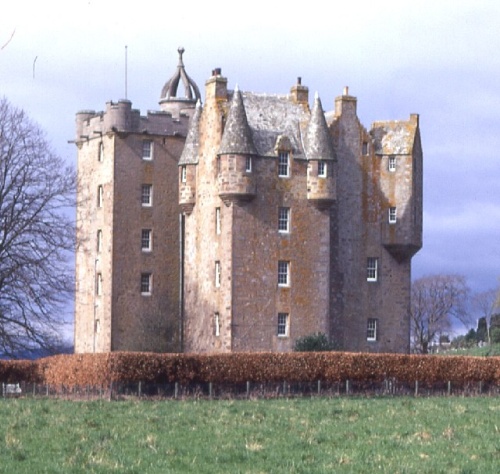
There are actually two ways to interpret this sub-heading. The first relates to the actual castle which was constructed in the 16th century by three successive Earls of Moray all called James Stewart (later changed to Stuart) after they were given the land not far from Inverness by Mary Queen of Scots. The first two James’ were assassinated, but the third survived and finished the job, including the distinctive crown on top which is the signature of Castle Stuart. However, as students of English history know, the Stuarts, who became the royal house of both Scotland and England after Mary’s son James took the throne, were ousted from that role in 1688 and fell on hard times. The castle was abandoned and stood empty for centuries until restored as a five star hotel by the same group that developed the golf course. Unfortunately Covid killed it off and at the time we played the course it was still closed. However, that is about to change as a new organization with direct ties to my home province of Nova Scotia takes the helm.
Castle Stuart, the golf course, was the brain child of Mark Parsinen an American businessman and golf enthusiast whose first venture in Scottish golf was the fabulous Kingsbarns course outside of St. Andrews. We played it on our first visit to Scotland and you can read my hole-by-hole description here. In terms of ‘modern’ coastal golf courses it ranks right up there with Old Head and Cabot Cliffs. Wishing to repeat the success of Kingsbarns, Parsinen sought out a piece of land in a more highland location and acquired not only Castle Stuart, but enough land around it to build several golf courses and associated facilities.
He hired up and coming American golf architect Gil Hanse and the two collaborated on the design which opened in 2009. The course was immediately hailed as a stunning golf achievement and debuted in the top 100 in the world, currently standing at #55 on the respected Top 100 Golf Courses website. Castle Stuart has played host to the Scottish Open on four occasions with Phil Mickelson and Luke Donald among the winners here. So while it might not have the provenance of a Royal Dornoch or Muirfield, when you play Castle Stuart you are playing where the best in the game have tested their mettle.
Sadly, Mark Parsinen died unexpectedly in 2019 and that combined with the Covid epidemic put future plans for more development at Castle Stuart on hold. That is until this year when a company that started in Nova Scotia, Cabot Golf purchased the property and immediately announced plans to have architect Tom Doak design a second course that will feature views of Castle Stuart from many holes. Cabot is a company co-founded by Canadian Ben Cowan-Dewar and American Mike Keiser who is the man behind the celebrated courses at Bandon Dunes, Oregon. The two courses in Nova Scotia, Cabot Cliffs and Cabot Links are both rated in the top #100 in the world with the Cliffs being the #1 course in Canada. The company also has developments in Revelstoke, British Columbia, St. Lucia and Florida. While many were predicting the slow demise of golf in the 21st century, the folks at Cabot have proven that given the right formula there is a huge demand for top quality golf experiences. Along with the new course, the castle will be reopened as a hotel and as in Cape Breton a variety of accommodations will be constructed on the property. In essence, Mark Parsinen’s long term dream for Castle Stuart is about to be fulfilled.
Here’s a link to a story I did a few years back for Saltscapes magazine which describes the changes that Cabot Links was about to bring to what had been a very depressed area of Nova Scotia. It turned out that my predictions were too modest as Cabot is now the major generator of investment and jobs in the entire area. I expect that much the same will happen at Castle Stuart which Cabot has officially renamed Cabot Highlands. For the purposes of this post I will continue to use Castle Stuart as I suspect that will get more hits for the next while than Cabot Highlands. Later I can revise the post to reflect the renaming of the course.
Castle Stuart is only a short distance from the city of Inverness and despite the fact that the change in ownership had only occurred a few weeks earlier the Cabot Highlands logo was already in evidence.
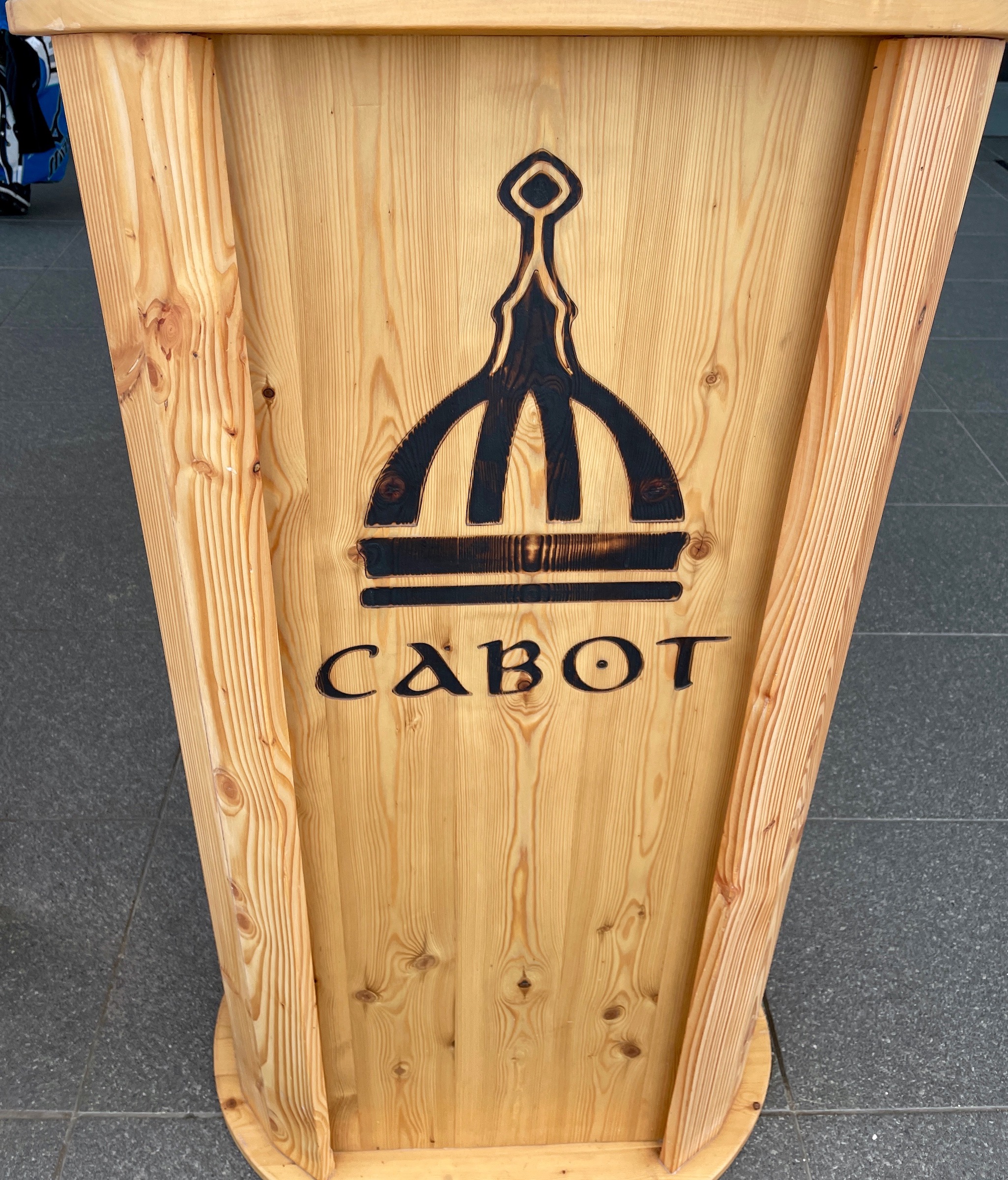
We arrived on a day that could not have been more different than that which greeted us in Royal Dornoch. The driving rain and wind were replaced by sunshine and this very nice portent of the day to come. The rainbow completely straddled the very impressive club house.
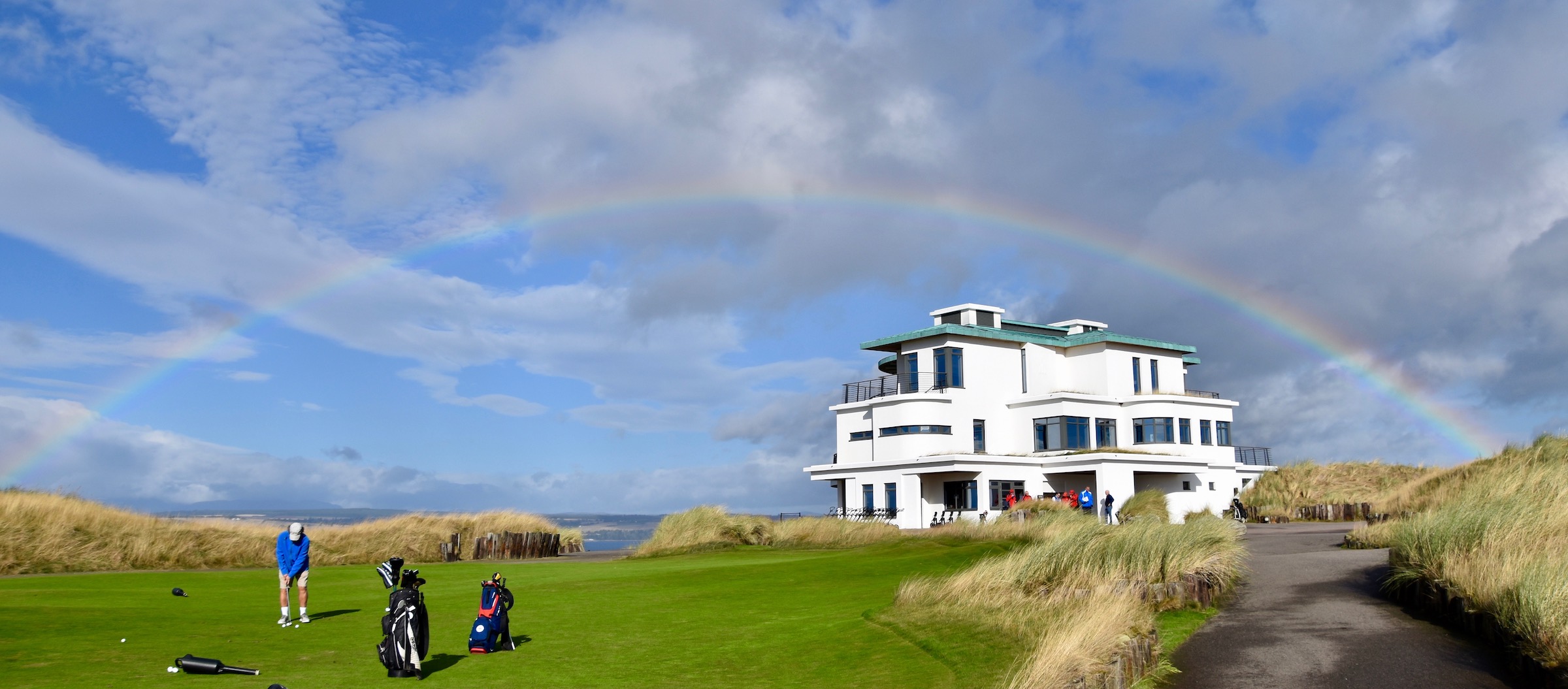
The practice facilities at Castle Stuart were the best we encountered on this trip. This is not surprising given that it is a new course and driving, chipping and putting areas would all be included in the initial design.
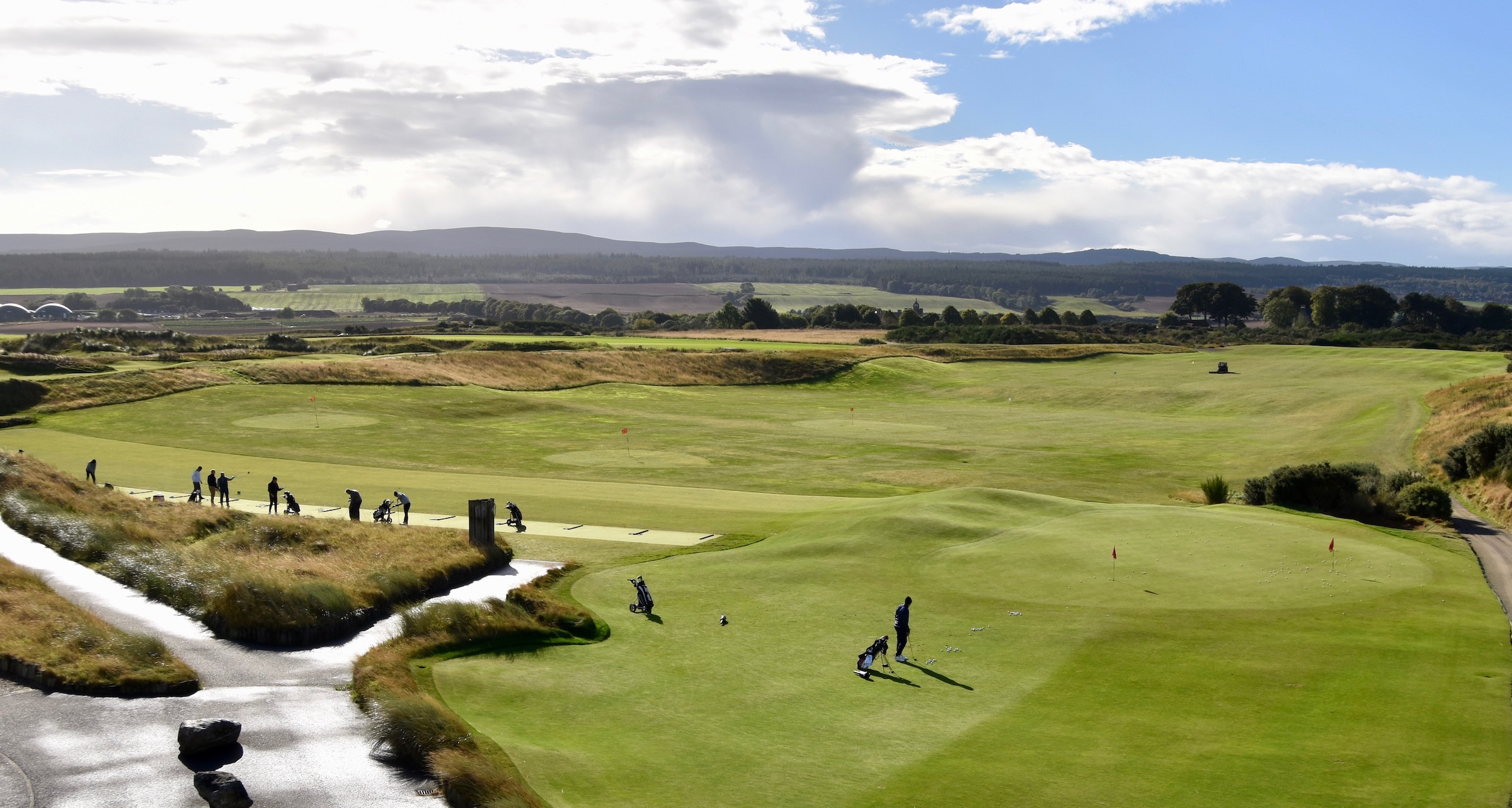
The practice green is immense with the three tiered clubhouse in the background.
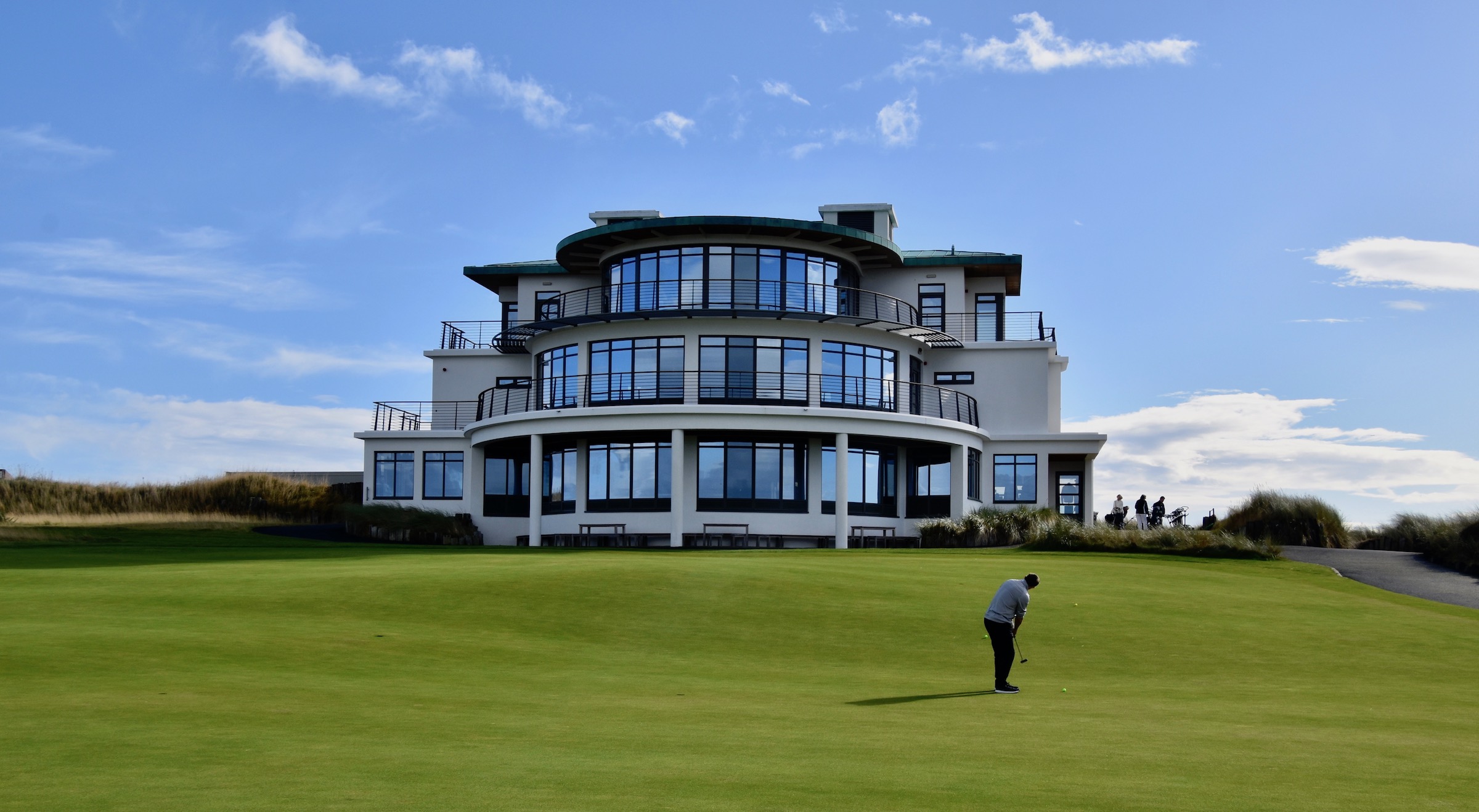
The interior of the clubhouse continues the circular theme adopted by the architects to bring to mind the many lighthouses found along the Scottish coastline.
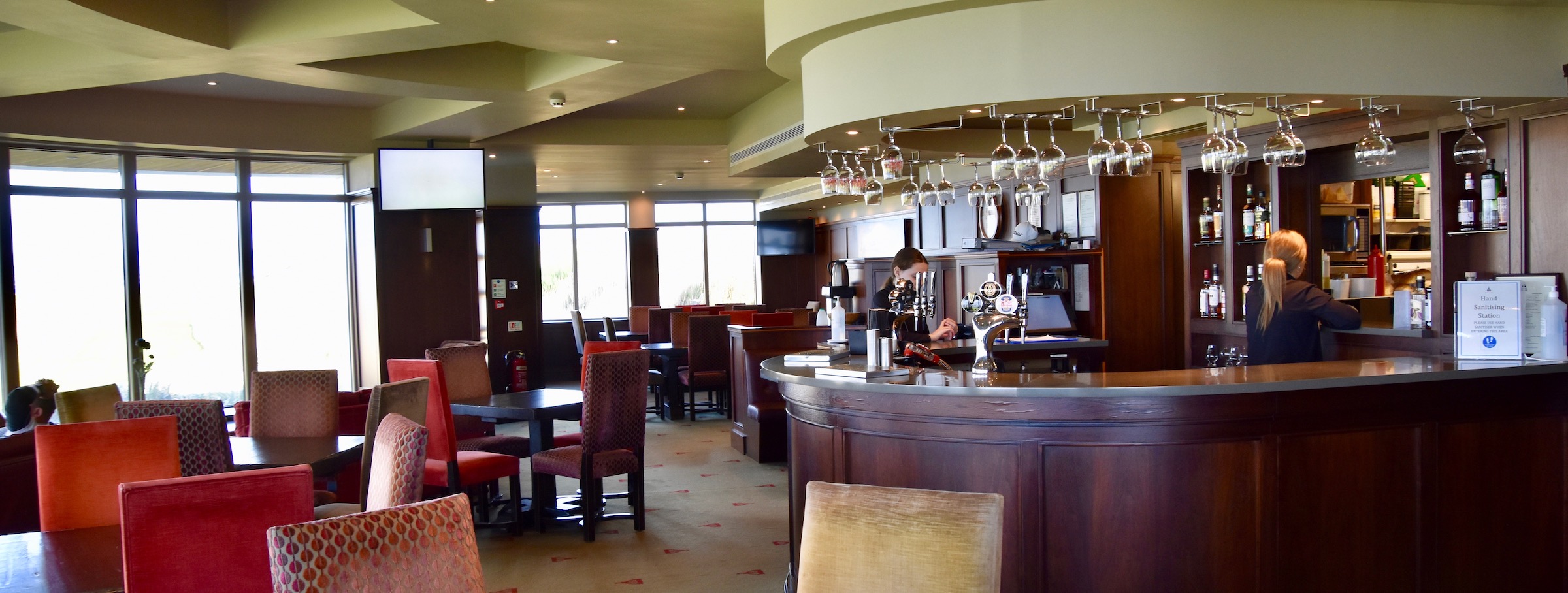
One thing you must do before teeing off is to go to the top of the clubhouse and go outside for amazing views of Moray Firth, Black Isle across the way and in particular, get this shot of the first hole. If this doesn’t get you amped up to play nothing will.
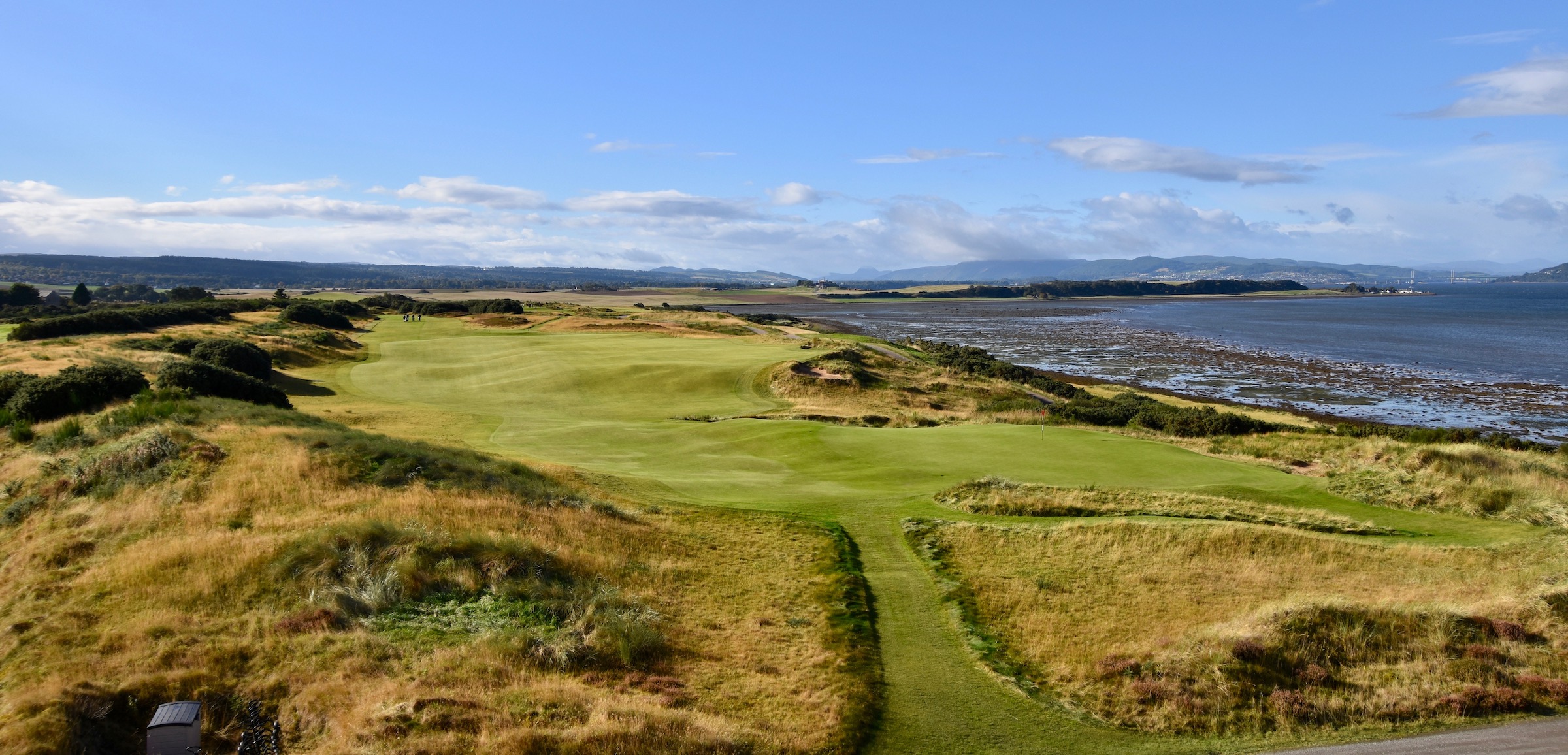
What makes Castle Stuart a modern course as opposed to a links course is that it is not built almost entirely on sandy seaside soil which was generally not suitable as farmland. The Nairn course just down the road is built on such a site with very little elevation change. Castle Stuart was built on what was formerly farmland and has considerable changes in elevation. However, what it does have in common with the best links courses are some stunning seaside holes and that’s where we’ll start our round today.
Castle Stuart #1 – 341 Yard Par Four

As you would expect for a course capable of hosting the Scottish Open, Castle Stuart plays well over 7,000 yards from the tips. Fortunately for our group of oldsters there are four sets of tees with lesser yardages. We opt to play the blue tees which at 5,724 yards makes sense for our abilities and length.
Visually this is as nice a starting hole as I can remember. With the sea on the right, some trouble in front and gorse on the left it looks more intimidating than it actually is. The fairway does slope left to right so if that is your ball flight you’ll need to start out well to the left. For my ball flight which is right to left this is a great driving hole.
The first thing I notice on reaching the fairway is just how soft and springy it is. This is a complete contrast to the very hard surfaces of traditional links courses. The fairways at Castle Stuart really feel nice on the feet and are a pleasure to walk.
This is the approach shot on #1 which is a lot more difficult than the drive with trouble everywhere but the front. The good news is that the greens at Castle Stuart are huge so you don’t have to be super accurate to find them, unlike the challenge at Royal Dornoch. The bad news is that greens at Castle Stuart are huge so if you do find them you might be a mile away from the cup.
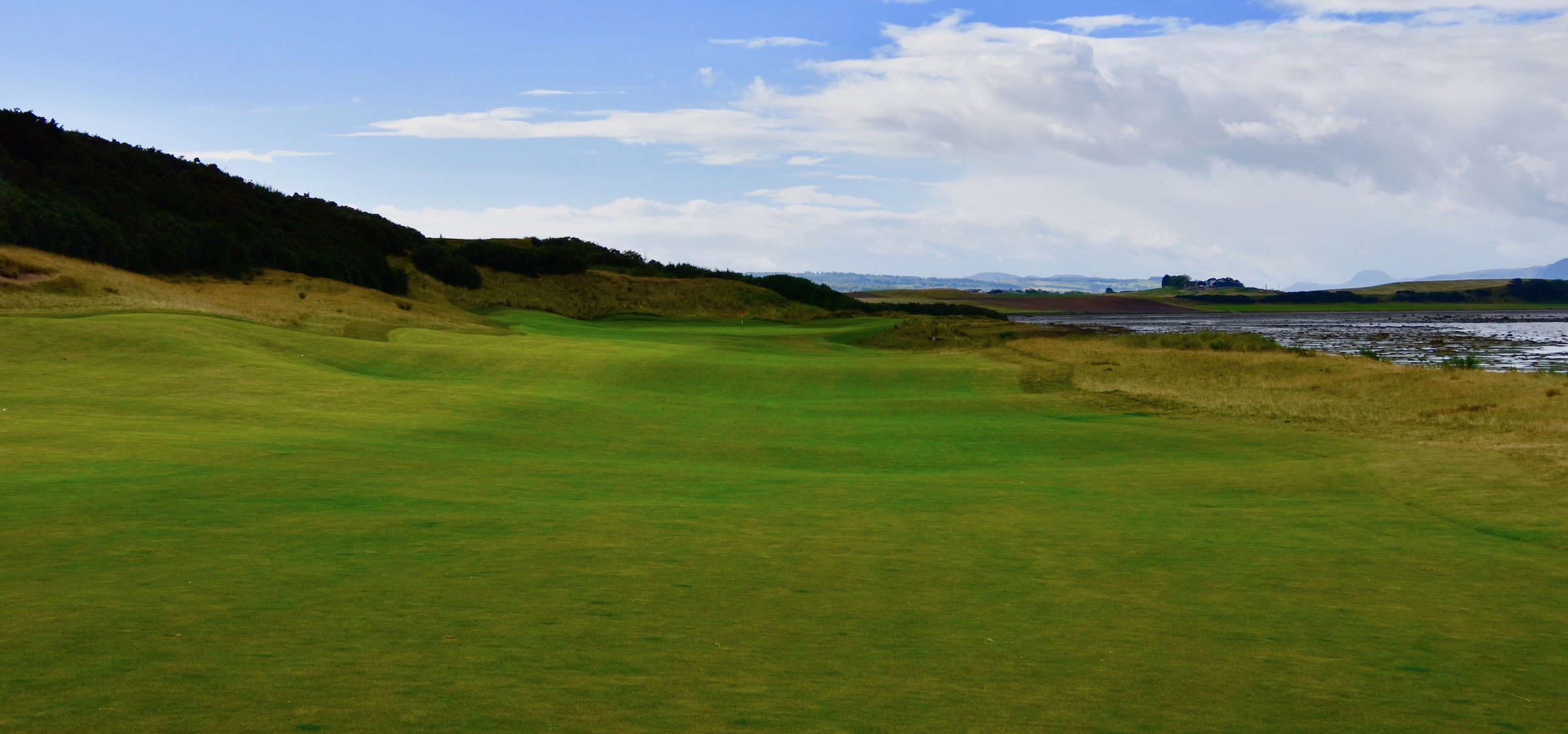
The greens are quite contoured which can lead to some nasty surprises if you get on the wrong side of one. In terms of speed they were fast, but not crazy. I think the first hole at Castle Stuart gives you a great preview of what this course is all about. It’s beautiful to walk, not demanding to the point of being unenjoyable and in tremendous condition from tee to green.
#2 – 486 Yard Par 5

The second hole fairway has two distinct levels. Longer hitters can reach the upper level, but most will find their drives on the lower level. The key here is to aim so far to the left that the fescue or worse are taken out of play. This is a three shot hole for mere mortals and playing it as such should leave this type of third shot to a large green that will hold a high pitch. Alternatively you can use the slope to guide a low running bump and run onto the green. This is a really impressive first par five. It does require three decent shots, but playing within your abilities makes par a good possibility.
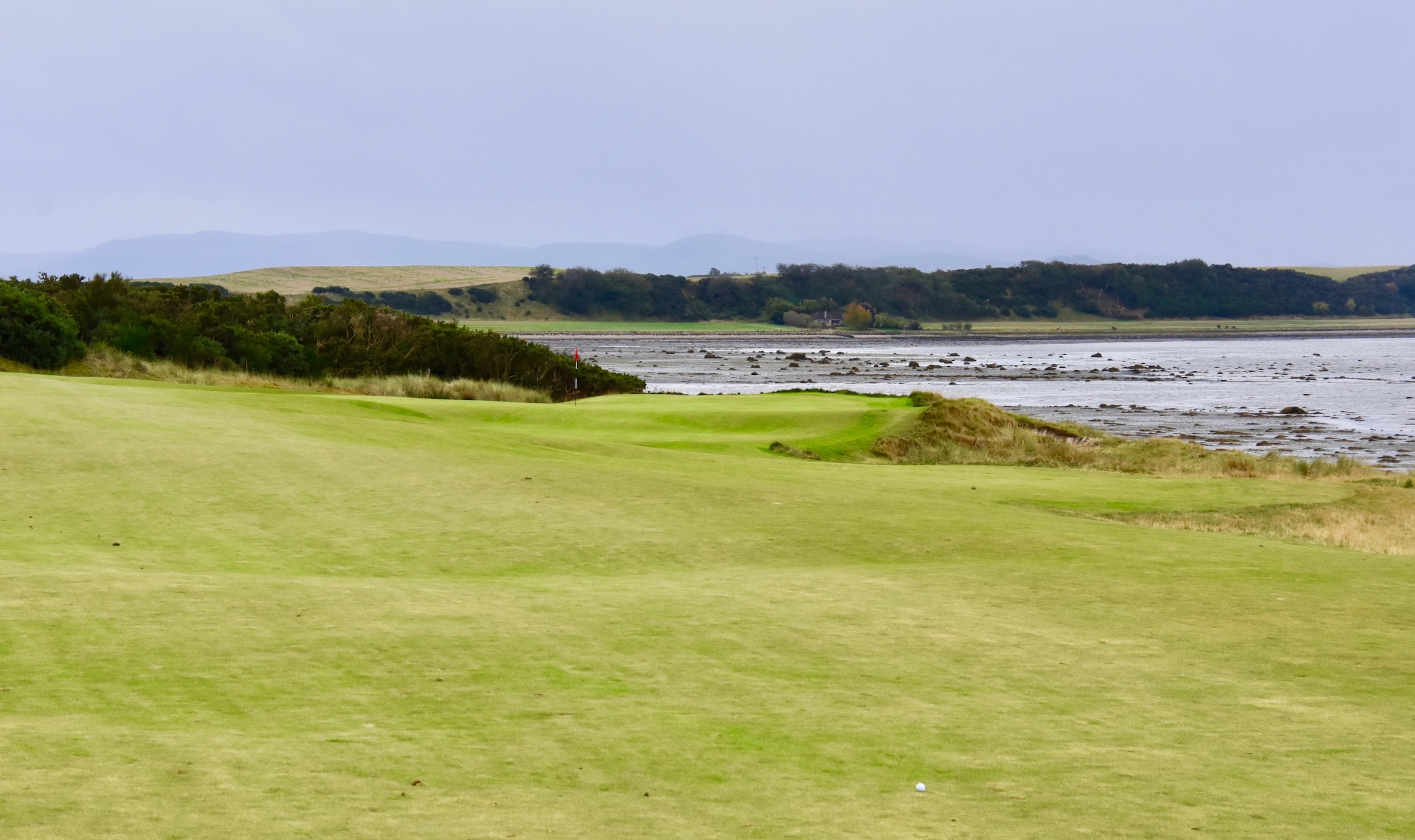
Castle Stuart #3 – 266 Yard Par Four

This very short par four is technically driveable in the right conditions, but more likely a good drive will end up where mine did – just a bit short.
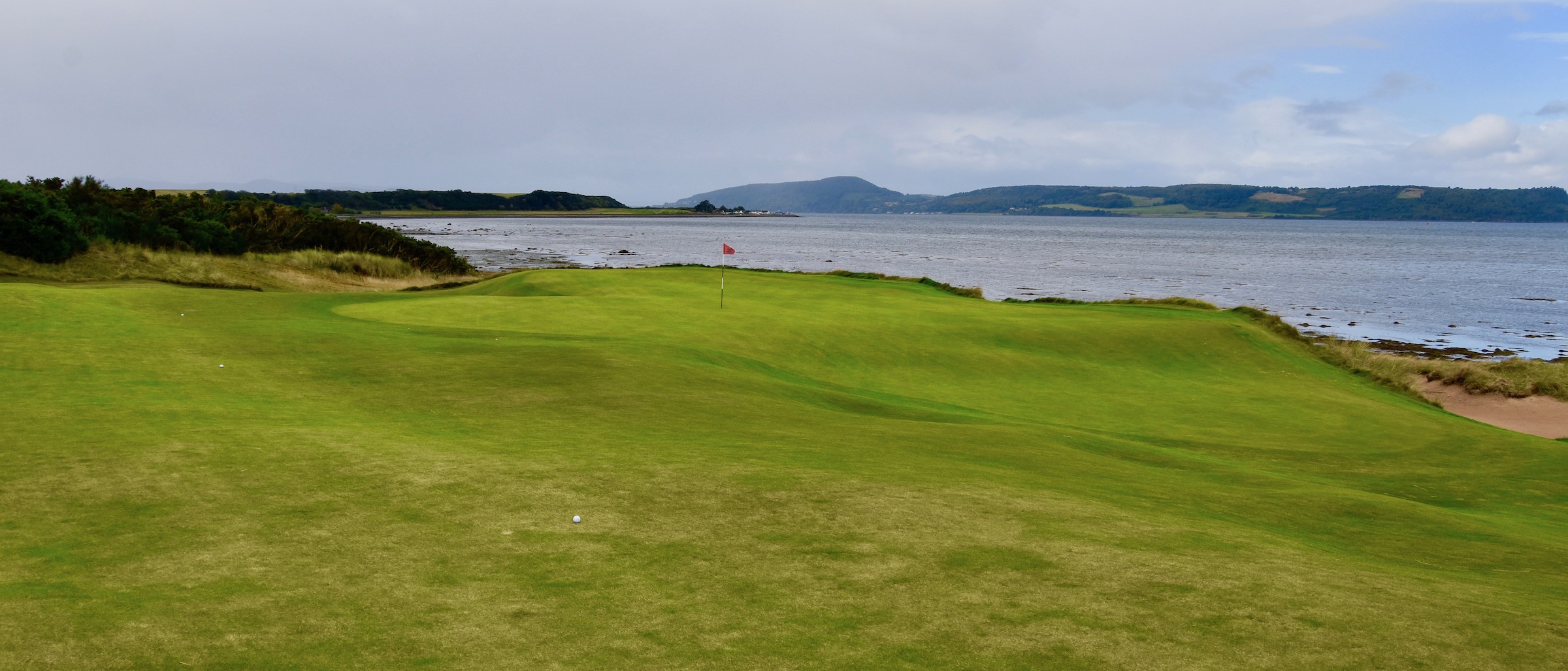
The real challenge here is the severely undulating green which makes a chip shot iffy. If you get a bad hop God knows where you’ll end up. A nice lob wedge to the upper tier should make for a decent birdie opportunity.
If you strike it to too far to the left you might be facing one of these. At first I thought they were miniature eyebrow traps, but actually they are something I have never encountered before. It is actually just a small cut out that is intended to take away the option of putting. You can see from the photo that we got a few drops of rain on this hole, but they disappeared as fast as they came.
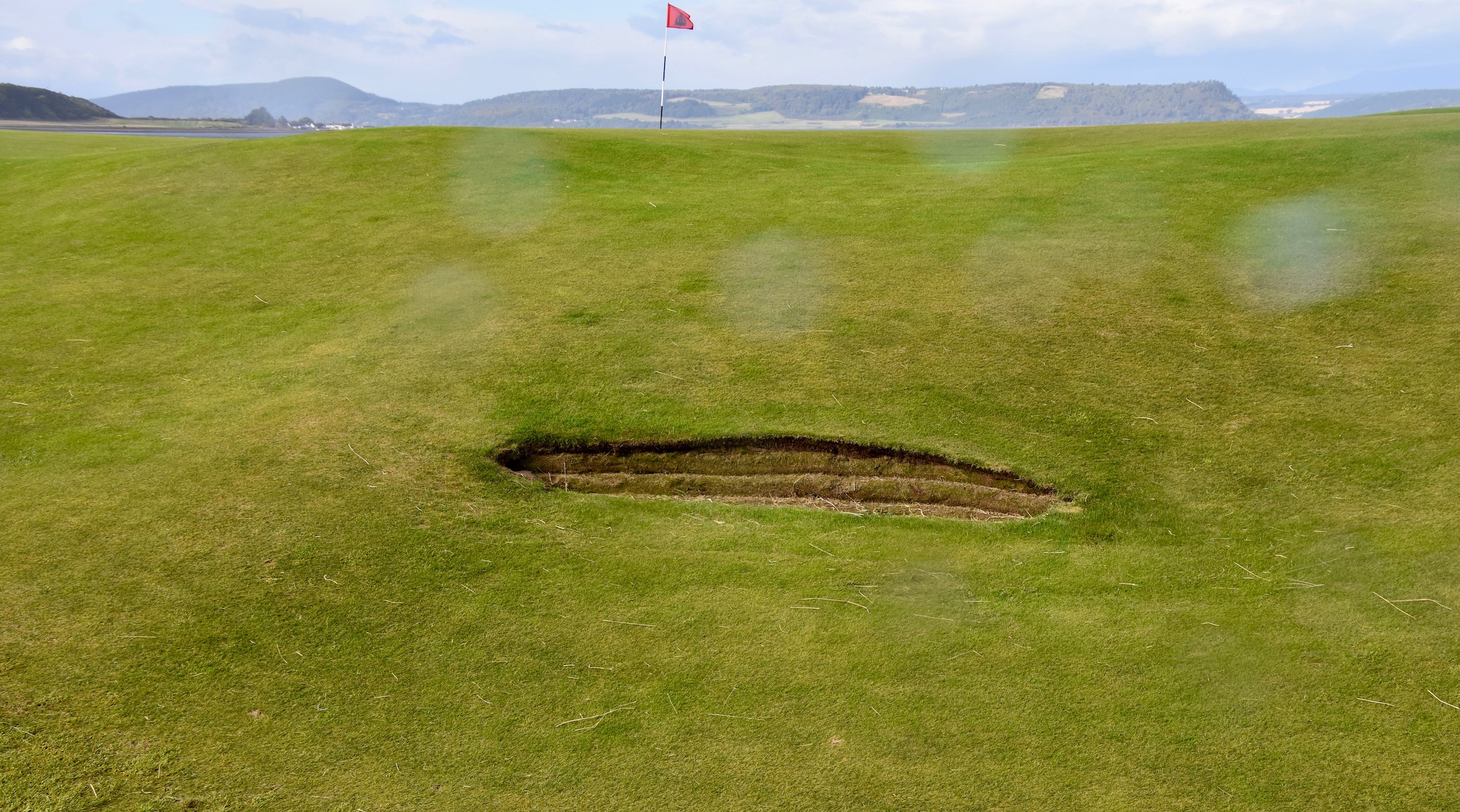
This is probably the best spot on the course for group shot. Why I’m wearing the toque I bought at Nairn is beyond me.

#4 161 Yard Par Three

After three great starting holes along Moray Firth Castle Stuart appears to turn inland, but actually you are on a peninsula with the sea now on your left although you don’t really see it. You won’t care because the sight of Castle Stuart with its crown or ‘open spire’ clearly visible in the background, makes this one of the most memorable par threes you will ever play. The green is massive and in somewhat of a bowl so that most shots will feed toward the green. This is another hole with birdie potential. Or you could just as easily three putt like I did.
Castle Stuart #5 – 332 Yard Par Four
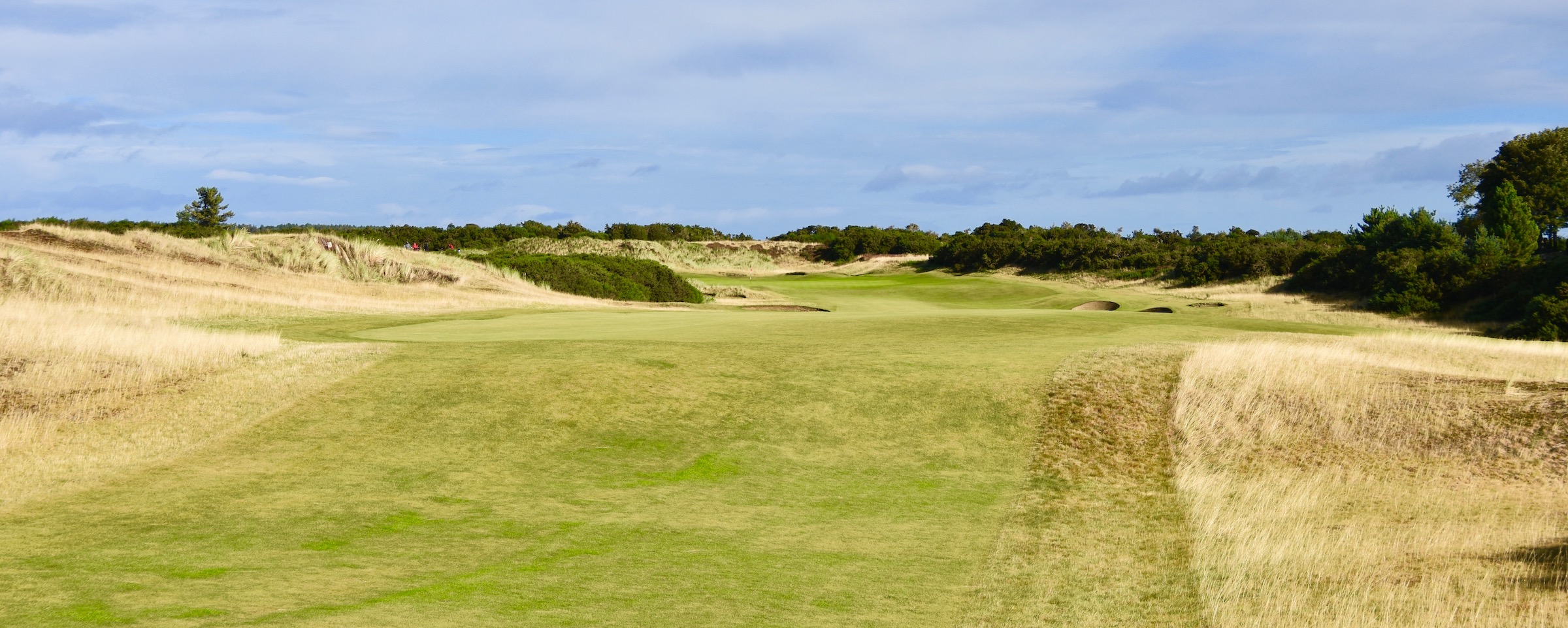
This hole is very different from the three back tees where it plays over 400 yards. However, for us geezers the tee is well forward making this a much less challenging hole. That said, the fairway is the narrowest we’ve seen so far and a really errant drive may find the gorse. Best to play it safe off the tee with a wood and make the approach with seven iron rather than attempt driver/wedge. I found this a very pleasing hole to the eye despite the fact there was no sea view or even a castle.
#6 – 505 Yard Par 5

On this hole you are headed back out toward the end of the peninsula with great views of the highlands in the distance. Like #5 it is a vastly different hole from the senior tees than from the regular men’s. You can see the forward tees on the right. We opted to play from the longer tees because a 411 yard par 5 is too embarrassing to admit to playing.
As you can see the fairway is very inviting with the only trouble on the right side. The challenge here is the third shot as the green is very narrow with steep drop offs on three sides. The well positioned trap takes away the bump and run to this really nice looking infinity green. You wouldn’t know that hole #3 is actually between the green and the water.
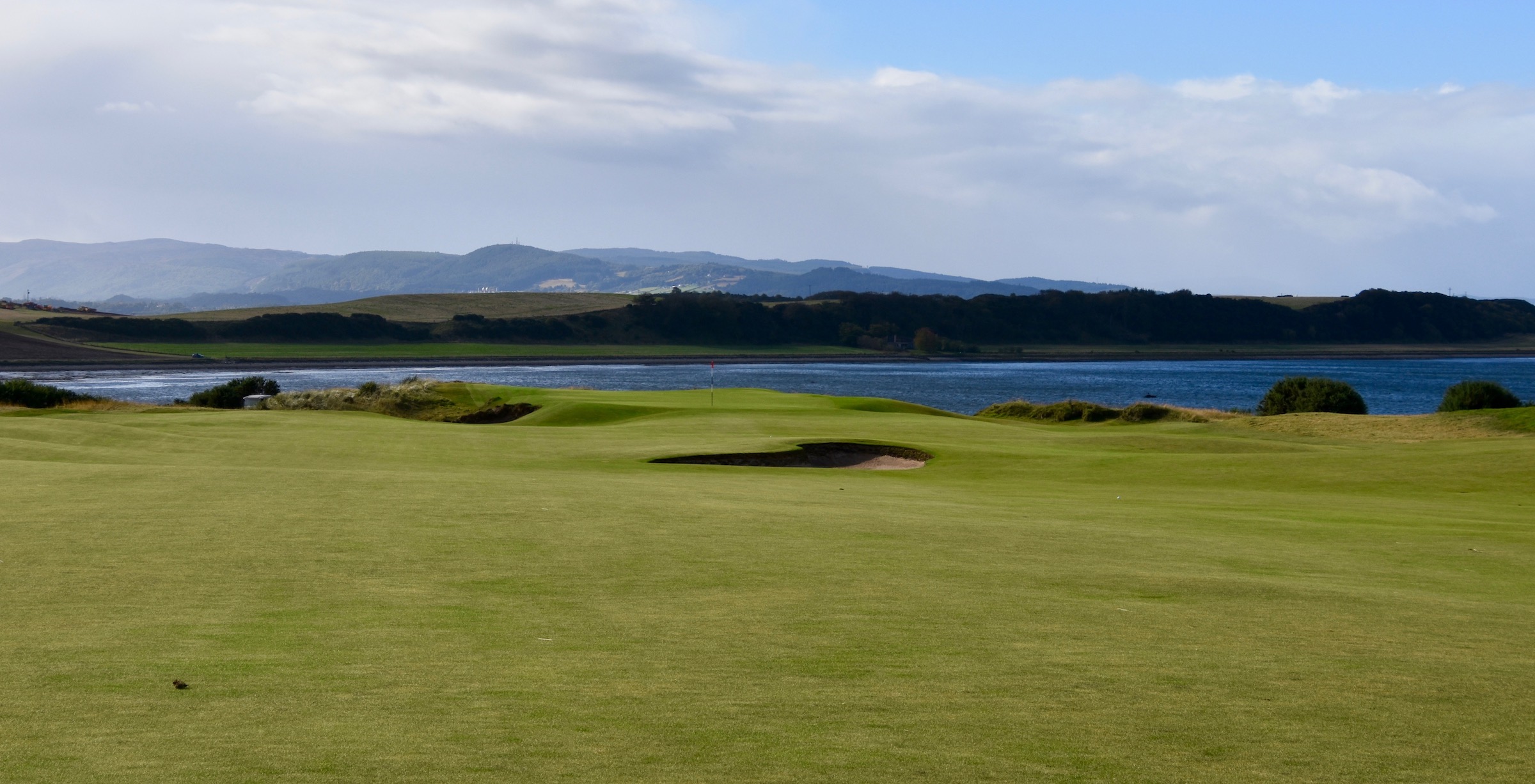
Castle Stuart #7 – 359 Yard Par 4

The final three holes on the front nine are all inland and play back to the clubhouse, but you still get great views on all of them. You can’t tell from this picture, but this hole is quite serpentine with a sharp dogleg leg and then a lurch back to the right. The hole also falls off steeply on the left side. To top it off the approach is by far the most difficult at Castle Stuart with trouble seemingly everywhere. It is the #1 handicap hole and it plays like it. If you get in trouble here a triple or worse is quite possible.
The good news is that once you get there, the views of Moray Firth from the green are excellent. Too bad I was so concerned about avoiding a triple that I forgot to take a photo. If up until now you thought Castle Stuart a fairly easy test, this hole will cure you of that thought very quickly.
#8 – 192 Yard Par Three

I love the look of this hole which, although downhill, still plays quite long. What you can’t see from the tee is that the green is massive and extends all the way to the right side of the photo. One member of group thought he was way too far right only to find himself with a hundred foot downhill putt. Don’t ask me how that turned out. There is also a mound at the front that needs to be avoided.
With this pin placement a well struck tee shot landing at the front of the green just to the right side of the pin should do the trick, but no one in our group could pull it off.
Castle Stuart #9 – 330 Yard Par Four
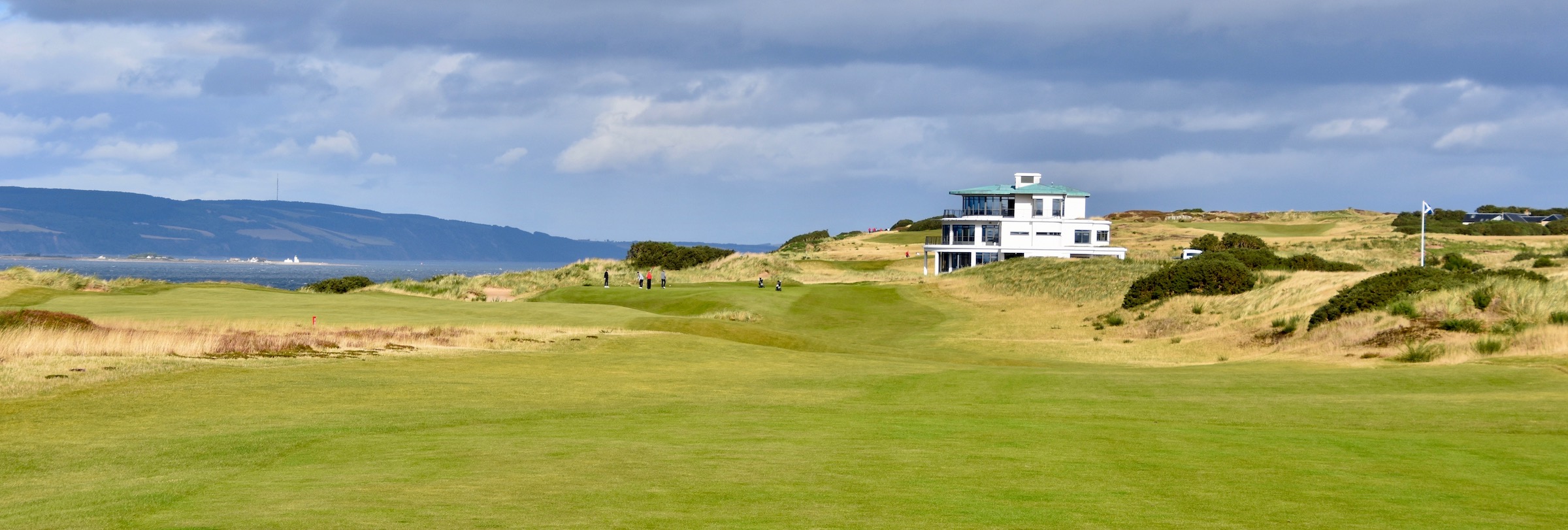
This is an intriguing final hole on the front with two very different ways to play it. If you go down the right side the fairway becomes extremely narrow and falls of steeply to the left (that’s becoming quite a theme). There is a more generous landing area on the left and you can see the green clearly from up there, but the second shot will need to carry all the way to the green or else you will end up in a wasteland seemingly miles below the green.
This photo gives a better view of the options. Up on the left it is quite a carry while on the right you can go well right of the green to avoid trouble, but you’ll need to scramble to save par. This is definitely a thinking man’s hole.
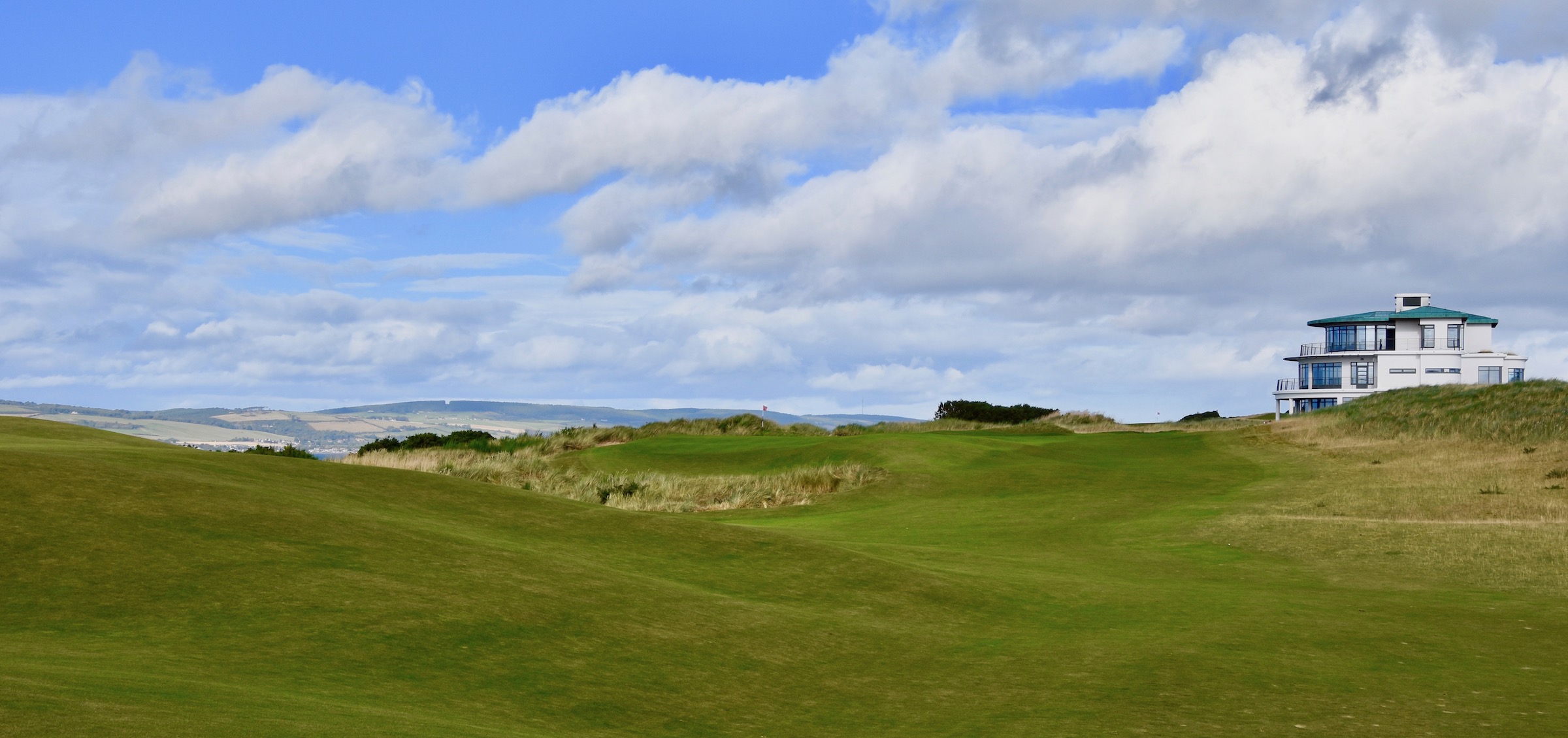
Unlike most links courses, Castle Stuart returns to the clubhouse after the front nine. The back nine is entirely on the opposite of the clubhouse, also with three starting holes alongside the sea and then the most difficult ascent we had on the entire tour to an upper plateau and an entirely different golf experience to finish the round. I need a beer just thinking about it.
#10 – 341 Yard Par Four

Contrast the look of #10 to that of #1. They appear to be almost mirror images with the sea on the left side now. However, the hill on the right side is now much steeper and higher than that on #1 and that will be a major factor on this back nine.
This fairway slopes right to left so most people will start out to the right and let the ball roll down to safety on the left side of the fairway from where there is a much better angle to the green. The only problem is that there is a fairway bunker you can’t see from the tee that is in the perfect spot to ruin a really good drive. Fortunately I seldom hit a really good drive so the bunker was not in play. A nice starting hole on the back, but not as memorable as #1.
Castle Stuart #11 – 115 Yard Par Three

Another absolutely gorgeous par three with lots of trouble, but short enough that most of it can be avoided. That was a sucker pin placement as two in our group found when they went right at. Far better to play to the right and hope for a fortuitous bounce off one of the mounds guarding that side. If you do get kicked the wrong way and end up in the gully below the green you can still use a putter as I did to salvage par. Once on the green look for Chanonry Lighthouse across the way. It is one of the many built by the great Stevenson firm which also built the more famous one at Turnberry.
#12 – 504 Yard Par Five

This is the final hole along Moray Firth at Castle Stuart and it packs a punch. It is by far the hardest of the par fives with many opportunities to go astray. However, it is a three shot hole to the green and if played conservatively you just might avoid all the trouble, especially around the green. If you don’t, enjoy the scenery and thank your lucky stars that you even got a chance to play this magnificent course.
Also, prepare to get winded as you now must ascend to the top of the hill that has gotten progressively higher as you’ve played the last three holes. The good news is that after your heart rate returns to normal, the views from up here might be the best on the course.
Castle Stuart #13 – 303 Yard Par Three
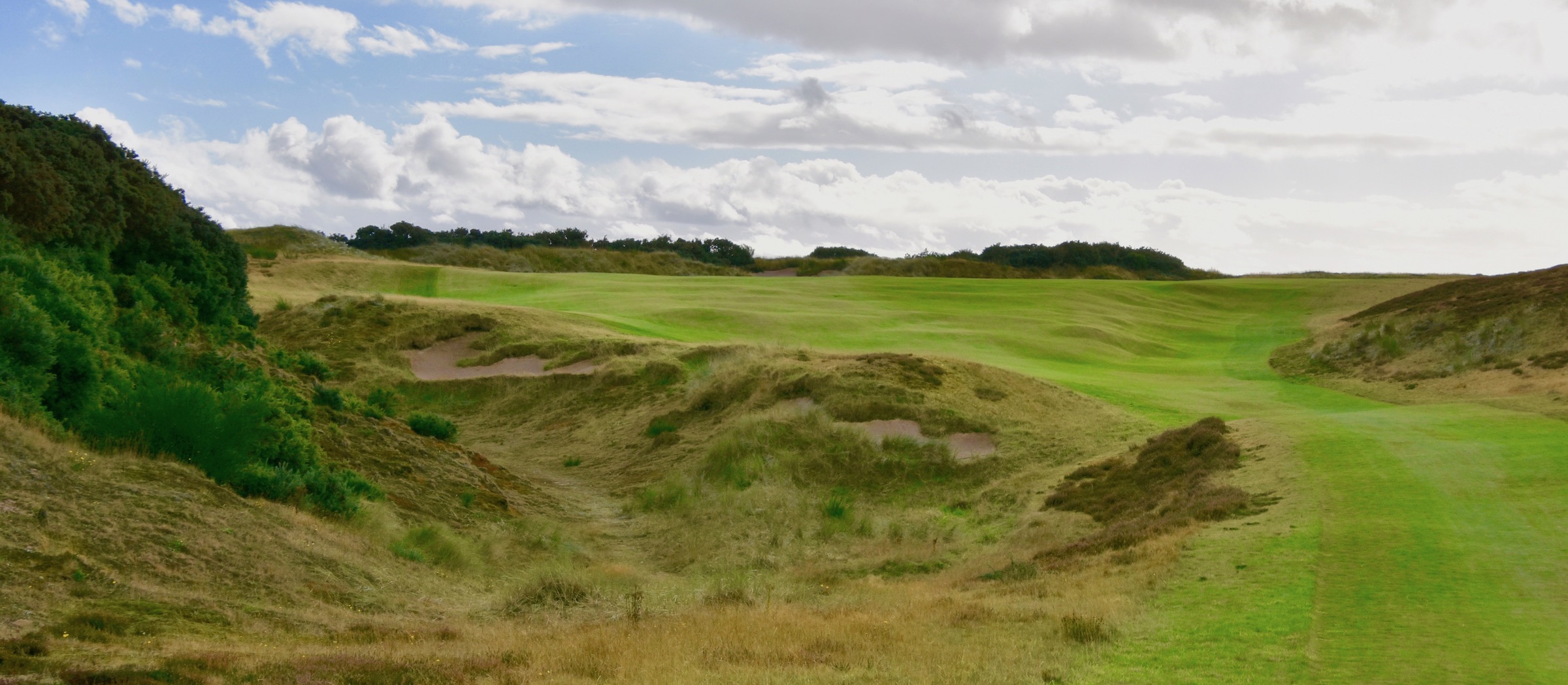
Holes 13 and 14 are the farthest from the sea at Castle Stuart and provide the setup for the final four which from where you will get great photos.
This is the first of two blind tee shots on the course and is a sharp dogleg right. It reminded me very much of #17 at Cabot Cliffs which has both of these characteristics as well. It’s not long so the only issue is how much of the dogleg are you going to try to cut off. The green is one of the smallest at Castle Stuart and it has a great view of Kessock Bridge in the distance.
#14 – 347 Yard Par Four
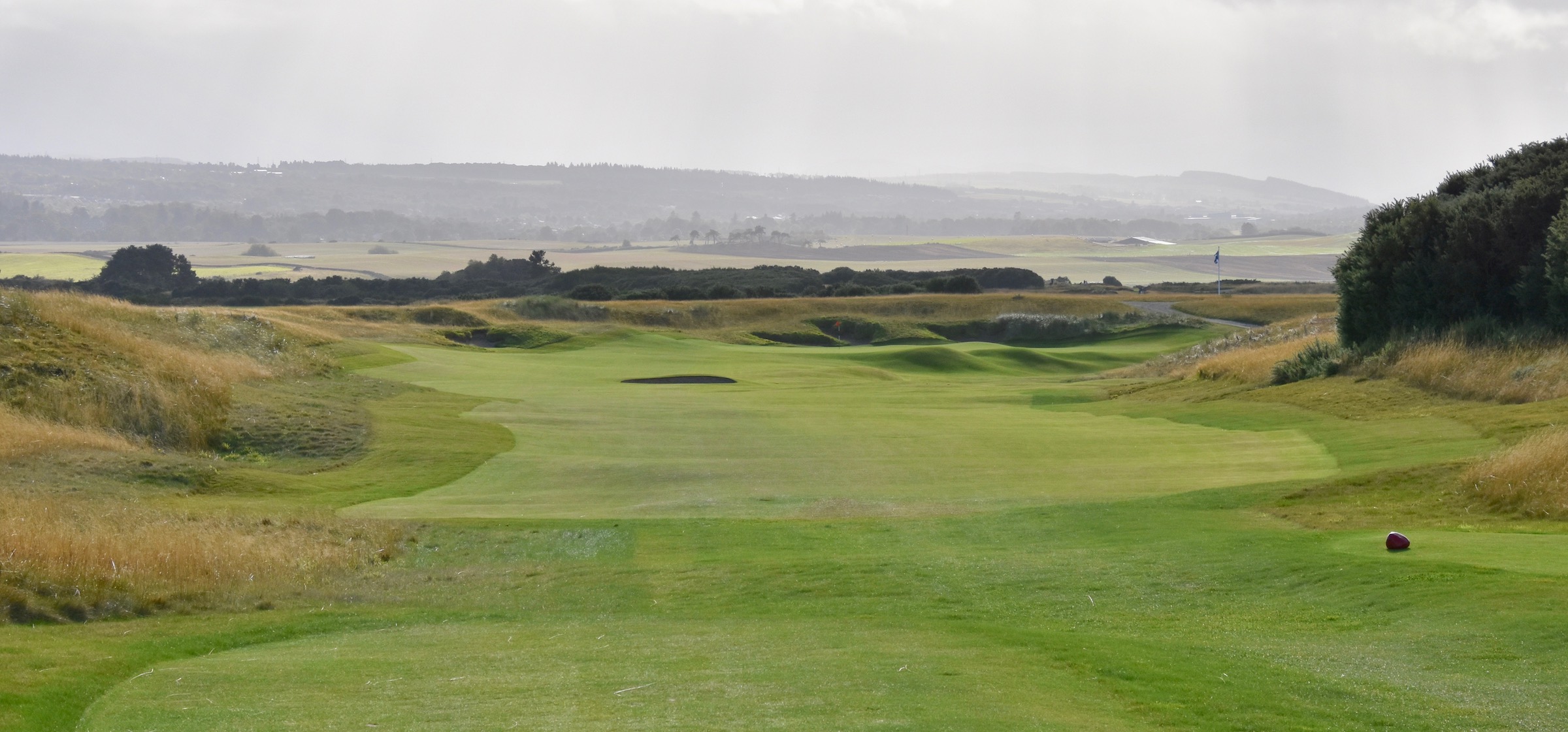
Somehow even without much in the way of scenery compared to most of the other holes at Castle Stuart, Hanse and Parsinen managed to create something special on this hole. With its sweeping curve of a green it has the look of a great par four and it is. That trap in the middle of the fairway is not reachable for most of us so just swing away. The green is immense and if you come up short a putter is still an option.
Castle Stuart #15 – 314 Yard Par Four
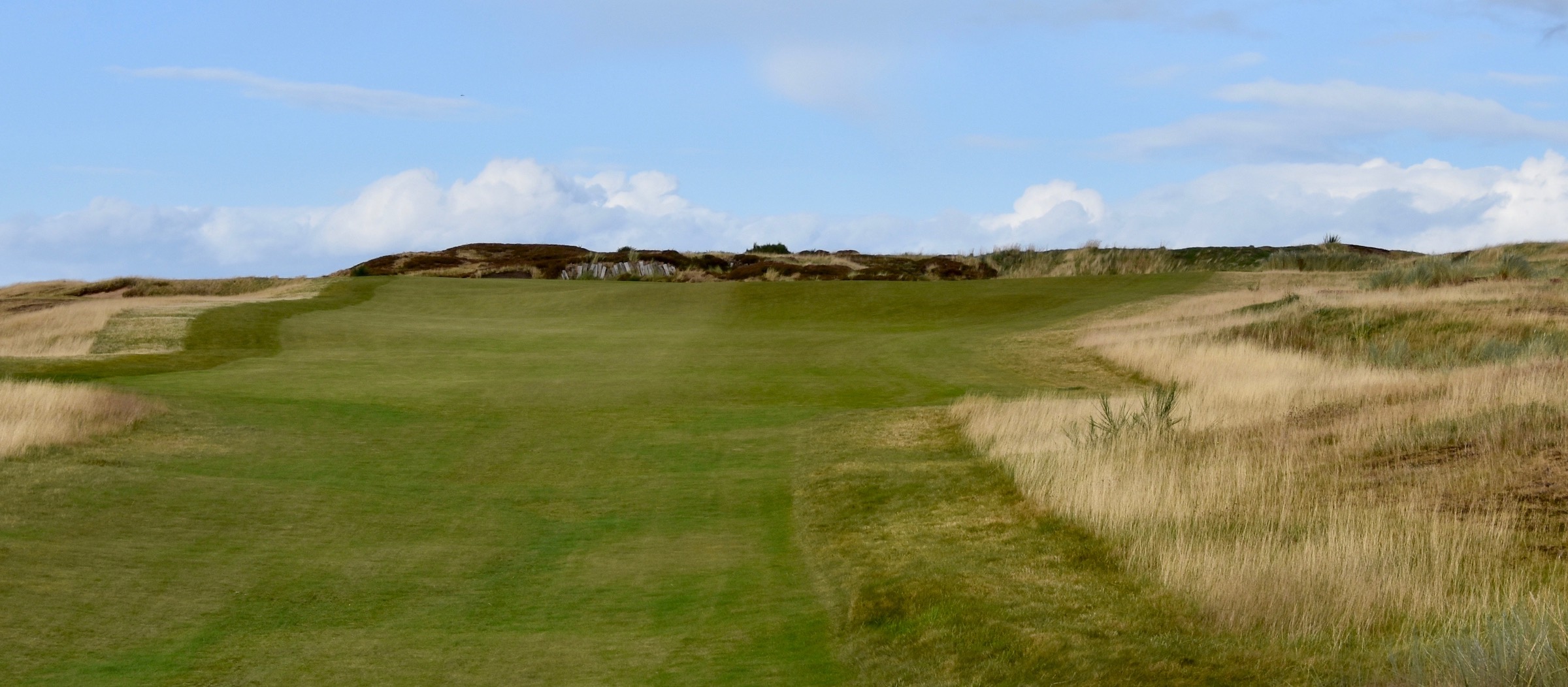
The other blind tee shot at Castle Stuart is probably my least favourite hole on the course. I don’t like blind tee shots to begin with and on this one there is more trouble than you might expect, especially on the right side. Although there is more fairway to work with on that side it’s easy to go too far and end up with no view of the green. This is definitely a hole to put away the driver and play conservatively down the left with probably a five wood. From there it will still not be that far to the green on this short hole.
#16 – 310 Yard Par Four
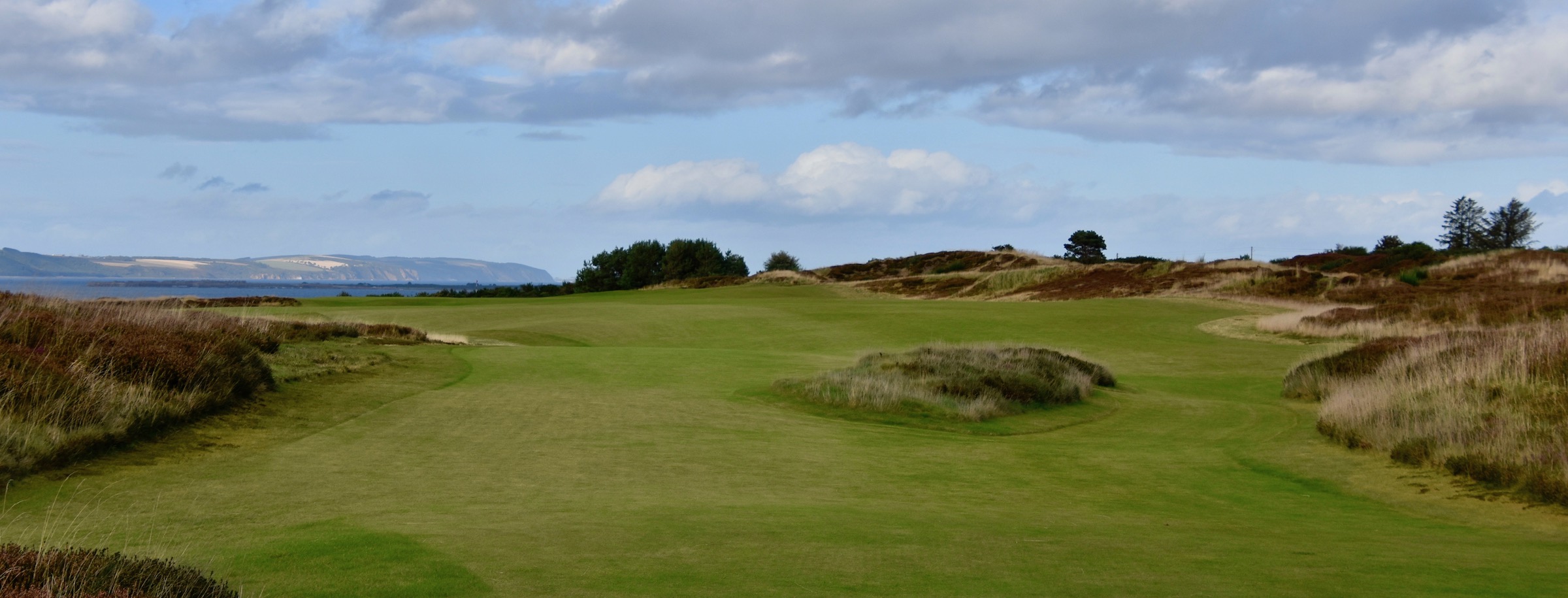
The fourth in a row of short par fours, #16 is definitely a grip it and rip it hole. There is virtually no trouble from tee to green for anything but a really bad drive. While I was not a fan of #15, this hole brought a smile to my face. The easiest hole on the course, #16 is definitely the best chance for a birdie at Castle Stuart.
Castle Stuart #17 – 133 Yard Par Three
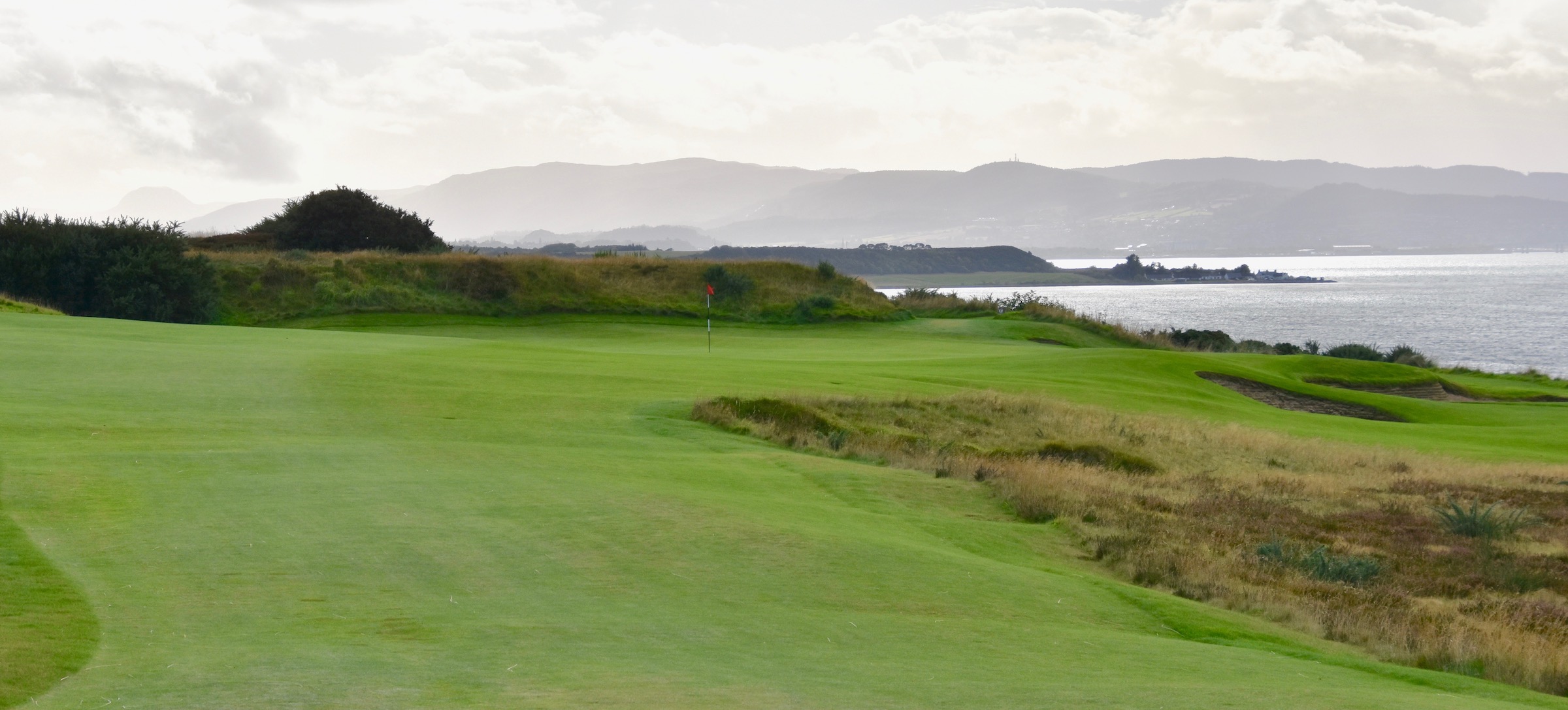
While from the senior tees at only 133 yards this is a relatively benign par three, from the other tees it is a monster, topping out at 224 yards. The key here is to stay left and let the natural contour of the hole take your ball to the green. The question is, how far left do you go before it’s too much and you end up in a small gully just below the gorse. It’s a nice conundrum that makes playing this hole a little more tricky than it might at first glance appear.
#18 – 490 Yard Par Five
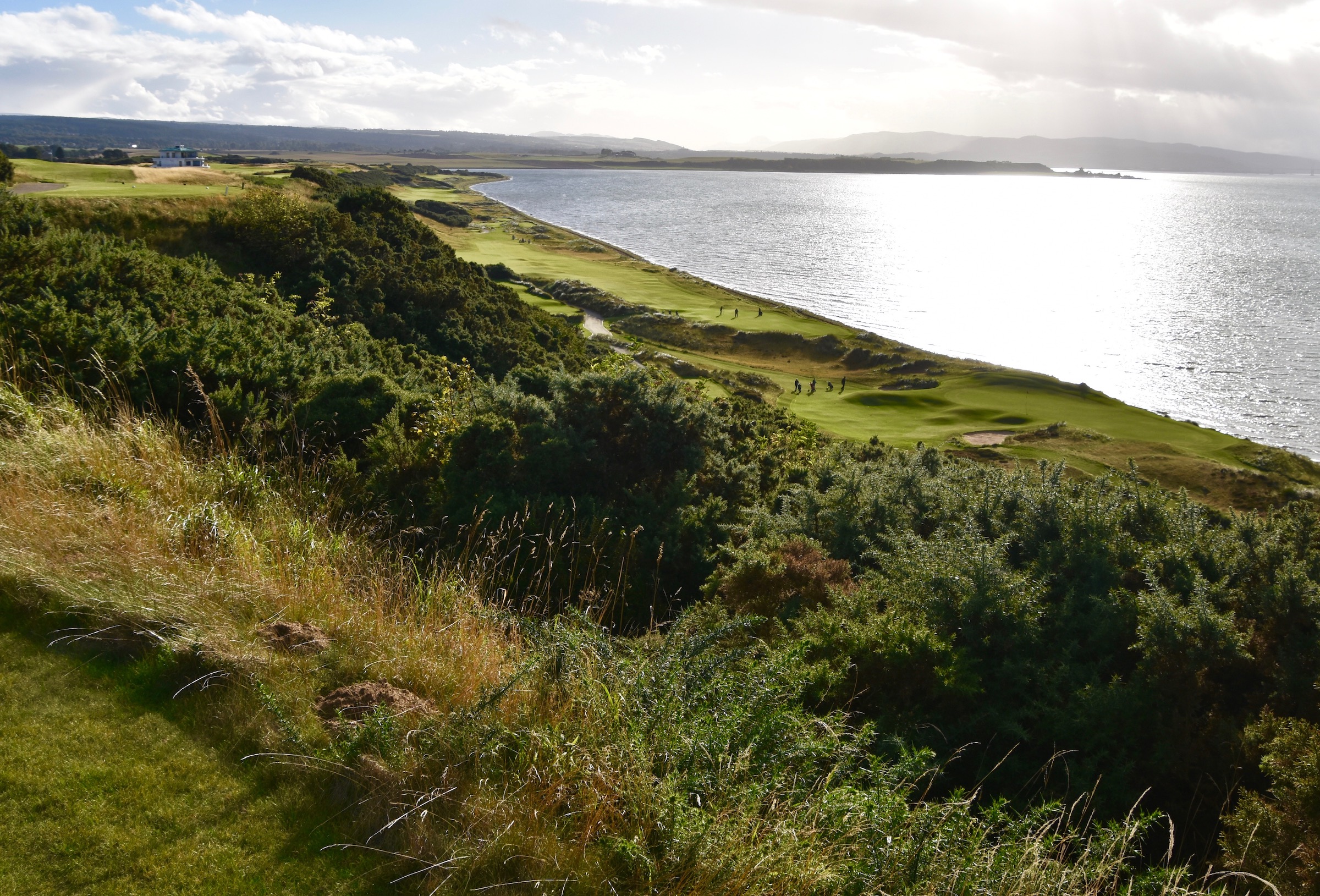
Look at this view from the #18 tee and you’ll realize just how steep that climb was from #12 to #13 and you’ll also realize once again what a beautiful course Castle Stuart really is. This has to be one the great views in all of golf.
This par five plays shorter than its stated yardage as it’s a fair ways down to the clubhouse from up here. It is a dogleg right and might be the only par five that the average golfer might consider trying to reach in two.

However, when you can see where you’re going that thought will quickly fade away. This is the largest green at Castle Stuart so playing it safe up the left side should land you there in three shots with a good chance to close out your round with a par or better.
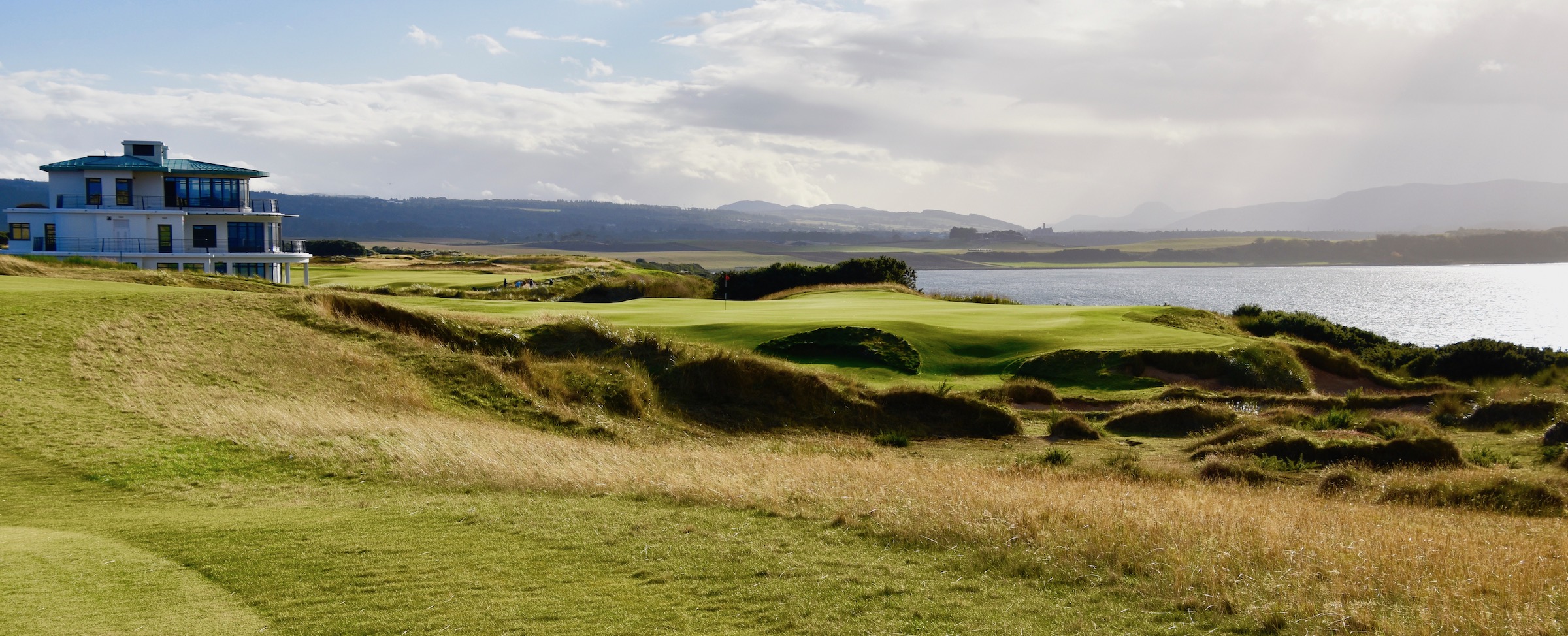
Castle Stuart is one of those courses where you wish it had more than eighteen holes, it was such a pleasure to play. Not only is it visually stunning, but it’s actually a joy to play. Hanse and Parsinen absolutely found the Goldilocks solution in this course design that satisfies the likes of Phil Mickelson while also being more than playable for the average Joe.
I can’t wait to see what Tom Doak comes up with for the new course and what the folks at Cabot do to complete Mark Parsinen’s dream of what Castle Stuart could be.
In the next post we’ll head for the city of Aberdeen and play three rounds out of there starting with Cruden Bay. See you on the links.

